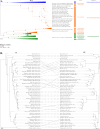To be or not to be a virus: A novel chimeric circular Rep-encoding single stranded DNA virus with interfamilial gene exchange illustrates the considerable evolutionary capacity of ssDNA viruses
- PMID: 40824887
- PMCID: PMC12360566
- DOI: 10.1371/journal.pone.0309278
To be or not to be a virus: A novel chimeric circular Rep-encoding single stranded DNA virus with interfamilial gene exchange illustrates the considerable evolutionary capacity of ssDNA viruses
Abstract
Viruses in the family Geminiviridae cause significant economic losses in numerous crops worldwide. Some geminiviruses are often associated with satellite DNA molecules, such as alphasatellites (familly Alphasatellitidae), that require the assistance of a helper virus for their transmission. Here, we report the discovery of a chimeric virus, tentatively named Cenchrus purpureus associated virus (CPAV), in Cenchrus purpureus plants in La Réunion. The genome of CPAV consists of a single component that is primarily geminivirus-like. It contains a rep gene phylogenetically most closely related alphasatellites. This rep gene is positioned upstream of, and in the same orientation as, the movement and capsid protein genes. Both of these genes are phylogenetically most related to members of the genus Mastrevirus (family Geminiviridae). We found that CPAV is associated in the field with Cenchrus purpureus mild streak virus (CPMSV). Using agroinfectious clones and insect transmission assays, we demonstrated that CPAV is able to initiate infections in C. purpureus but its ability to establish long-term infection and be insect transmitted is apparently facilitated by CPMSV. This raises the question of whether CPAV qualifies as an autonomous virus or rather a satellite-like element with partial autonomy. The chimeric nature of CPAV illustrates the interfamily gene exchange between circular ssDNA viruses and satellites and how such recombination events can blur the boundaries between viruses and subviral agents. These findings highlight the evolutionary plasticity of circular ssDNA viruses and suggest that chimerism may be a key mechanism driving the emergence of novel viral forms with modified pathogenicity and host range.
Copyright: © 2025 Ben Chéhida et al. This is an open access article distributed under the terms of the Creative Commons Attribution License, which permits unrestricted use, distribution, and reproduction in any medium, provided the original author and source are credited.
Conflict of interest statement
The authors have declared that no competing interests exist.
Figures



Similar articles
-
Prescription of Controlled Substances: Benefits and Risks.2025 Jul 6. In: StatPearls [Internet]. Treasure Island (FL): StatPearls Publishing; 2025 Jan–. 2025 Jul 6. In: StatPearls [Internet]. Treasure Island (FL): StatPearls Publishing; 2025 Jan–. PMID: 30726003 Free Books & Documents.
-
Short-Term Memory Impairment.2024 Jun 8. In: StatPearls [Internet]. Treasure Island (FL): StatPearls Publishing; 2025 Jan–. 2024 Jun 8. In: StatPearls [Internet]. Treasure Island (FL): StatPearls Publishing; 2025 Jan–. PMID: 31424720 Free Books & Documents.
-
Sexual Harassment and Prevention Training.2024 Mar 29. In: StatPearls [Internet]. Treasure Island (FL): StatPearls Publishing; 2025 Jan–. 2024 Mar 29. In: StatPearls [Internet]. Treasure Island (FL): StatPearls Publishing; 2025 Jan–. PMID: 36508513 Free Books & Documents.
-
The Black Book of Psychotropic Dosing and Monitoring.Psychopharmacol Bull. 2024 Jul 8;54(3):8-59. Psychopharmacol Bull. 2024. PMID: 38993656 Free PMC article. Review.
-
Management of urinary stones by experts in stone disease (ESD 2025).Arch Ital Urol Androl. 2025 Jun 30;97(2):14085. doi: 10.4081/aiua.2025.14085. Epub 2025 Jun 30. Arch Ital Urol Androl. 2025. PMID: 40583613 Review.
References
-
- Dayaram A, Galatowitsch ML, Argüello-Astorga GR, van Bysterveldt K, Kraberger S, Stainton D, et al. Diverse circular replication-associated protein encoding viruses circulating in invertebrates within a lake ecosystem. Infect Genet Evol. 2016;39:304–16. doi: 10.1016/j.meegid.2016.02.011 - DOI - PubMed
LinkOut - more resources
Full Text Sources

